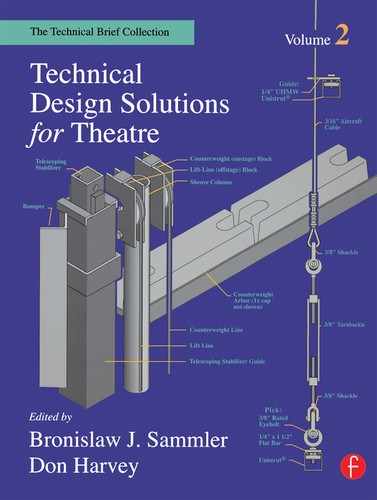Doug Harvey |
A Hot-Wire Bow for Cutting Blue Foam |
Whether or not we’ve actually tried it ourselves, most of us know that a carefully guided hot wire can cut blue foam slabs and blocks into elaborate cornices and other architectural details very efficiently. The technique takes so little time and the resulting pieces are so feather-light that some shops have virtually abandoned the much more tedious process of assembling lumber, plywood, and veneer of one sort or another into complex and heavy mouldings. The simply built hot-wire bow described in this article, the descendant of an earlier version developed at the Santa Fe Opera, could be a valuable tool for any scene shop.

FIGURE 1: THE HOT-WIRE BOW
CONSTRUCTION
The bow, pictured in Figure 1, consists of a 1″ square tube steel frame, two blocks of ¾″ plywood, a spring, a length of 22-gauge nichrome wire, and a length of 14-gauge SO cable. The long side of the tube steel frame measures 3′-10″ overall, with both ends mitred at 15°. Two 18″ lengths of box tube welded to those ends give the frame a rough “C” shape. Other frame sizes are possible, of course, but a bow built to these dimensions can cut foam slabs nearly 4′-0″ long.
The plywood blocks attached to the ends of the completed frame with ¼″ bolts insulate the frame electrically and thermally from the cutting wire and also provide a means for tensioning the wire. During setup, the 1 ½″ × 3″ plywood block (Block A in Figure 1) is rotated to tension the wire lightly and then is locked down securely to the frame. The spring and the 1 ½″ × 6″ plywood block (Block B) maintain wire tension during the bow’s use. Two washers between the frame and block B allow it to pivot fairly easily. No washers are used between the frame and block A. The spring is attached to both the frame and block B by means of eye bolts.
The nichrome wire, chosen because it heats more evenly than other types of wire, is tightly wrapped around 1″-long¼″ bolts and then bolted securely to the free ends of the plywood blocks. Each end of the wire is then attached to one of the leads of the SO cable. The bow is run from a step-down transformer that is itself plugged into an autotransformer. The step-down transformer performs the essential safety function of isolating the exposed nichrome wire from ground, while the autotransformer allows the power sent to the wire to be varied. Any 120-volt AC-primary transformer that will supply 15 amps or more at 12 to 24 volts at the secondary will work as the step-down. (One surplus transformer dealer, C&H Sales Co., Pasadena, CA, 1-800-325-9456, sells several different ones for around $40 each.) The SO cable’s ground wire is screwed or bolted directly to the bow’s tube steel frame and attached to the grounding pin of the plug powering the autotransformer. See the schematic in Figure 2.

FIGURE 2: SCHEMATIC
OPTIONS FOR USE
This bow can, with practice and patience, be hand-held and used to sculpt shapes from blocks of foam. More commonly it can be mounted vertically and used like a band saw or scroll saw, or it can be mounted horizontally and used to slice a thick slab of foam into thinner slabs or to plane a slab down to a desired thickness. Used in combination with shop-built guides or jigs, it can quickly turn out identical lengths of cornice or other moulding, ready for covering and painting.
SAFETY AND HEALTH CAUTIONS
Despite the electrical isolation provided, under no circumstances should anyone touch the nichrome wire, and the bow should be unplugged except when actually being used. Further, since the wire is so exposed, it is quite susceptible to breakage and replacement. Users must be doubly careful — before each use and periodically during each use — to check the circuit for continuity and to make sure that all connections are secure and protected from mechanical damage. Users must also take care to avoid contact with the hot wire itself and to warn others to keep away. And, finally, using any heat source to shape foams produces a number of noxious gases, including potentially deadly isocyanates. Consequently, use of this bow requires that the work station and adjacent areas be appropriately ventilated, that all workers wear respirators fitted with the proper filters, and that frequent work breaks be scheduled and taken to limit exposure to harmful chemicals.
